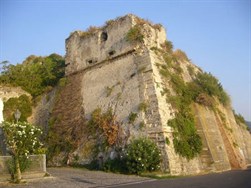The Calabria of the Ruffo: San Lucido, Maida, Fiumara di Muro
 The Castle of San Lucido was commissioned by Bishop Arnulfo around 1092 for defensive purposes against any attacks from the sea. The remains of the walls of the old castle, with embrasures, a terreplein and the bridge that connected the castle to the church of San Giovanni Battista. The fort belonged to the princes Ruffo di Calabria and was the birthplace, in 1744, of Cardinal Fabrizio Ruffo, chief of the Sanfedista army. It was partially destroyed by an earthquake in 1908.
The Castle of San Lucido was commissioned by Bishop Arnulfo around 1092 for defensive purposes against any attacks from the sea. The remains of the walls of the old castle, with embrasures, a terreplein and the bridge that connected the castle to the church of San Giovanni Battista. The fort belonged to the princes Ruffo di Calabria and was the birthplace, in 1744, of Cardinal Fabrizio Ruffo, chief of the Sanfedista army. It was partially destroyed by an earthquake in 1908.
 In December of 1691 Cardinal Fabrizio Ruffo bought the estate of Maida. After his death (1692) his nephew Francis succeeded him at first, then the latter’s son Carlo, and, gradually, other heirs of the family, including Ippolita, raised in Maida, who, after the earthquake of 1783 had a spinning mill opened, to revive the village and promoted the establishment of small tanneries. In the town are still the ruins of the ancient castle, in a square shape with four towers at the corners. From one of the eastern towers its body is still clearly visible, although it is partially hidden by modern buildings. It was home to a prison, of which there are still some cells and a slate staircase.
In December of 1691 Cardinal Fabrizio Ruffo bought the estate of Maida. After his death (1692) his nephew Francis succeeded him at first, then the latter’s son Carlo, and, gradually, other heirs of the family, including Ippolita, raised in Maida, who, after the earthquake of 1783 had a spinning mill opened, to revive the village and promoted the establishment of small tanneries. In the town are still the ruins of the ancient castle, in a square shape with four towers at the corners. From one of the eastern towers its body is still clearly visible, although it is partially hidden by modern buildings. It was home to a prison, of which there are still some cells and a slate staircase.
 The Ruffo di Bagnara acquired the fief of Fiumara di Muro, on the other hand, in the twenties of the seventeenth century, as a result of their marriage strategies and it remained among the possessions of the family until the abolition of feudalism. In the seventeenth century the “state of Fiumara di Muro” was formed from the territory corresponding to the current cities of Fiumara, Villa San Giovanni, Campo Calabro, San Roberto and Catona, for which, in 1651, the Ruffo di Bagnara obtained the title of princes from Philip IV, then in 1682 they moved to Motta San Giovanni. The earthquake of 1783 caused extensive damage in Fiumara: all the churches, convents and the castle were destroyed. The castle of Fiumara was one of the best defensive bulwarks against Turkish incursions. It was in the castle, it is said, that a small army of armed men had been assembled under the command of Ruffo, who had driven back the pirates of Barbarossa who landed in 1533 on the beach of Catona into the sea.
The Ruffo di Bagnara acquired the fief of Fiumara di Muro, on the other hand, in the twenties of the seventeenth century, as a result of their marriage strategies and it remained among the possessions of the family until the abolition of feudalism. In the seventeenth century the “state of Fiumara di Muro” was formed from the territory corresponding to the current cities of Fiumara, Villa San Giovanni, Campo Calabro, San Roberto and Catona, for which, in 1651, the Ruffo di Bagnara obtained the title of princes from Philip IV, then in 1682 they moved to Motta San Giovanni. The earthquake of 1783 caused extensive damage in Fiumara: all the churches, convents and the castle were destroyed. The castle of Fiumara was one of the best defensive bulwarks against Turkish incursions. It was in the castle, it is said, that a small army of armed men had been assembled under the command of Ruffo, who had driven back the pirates of Barbarossa who landed in 1533 on the beach of Catona into the sea.
